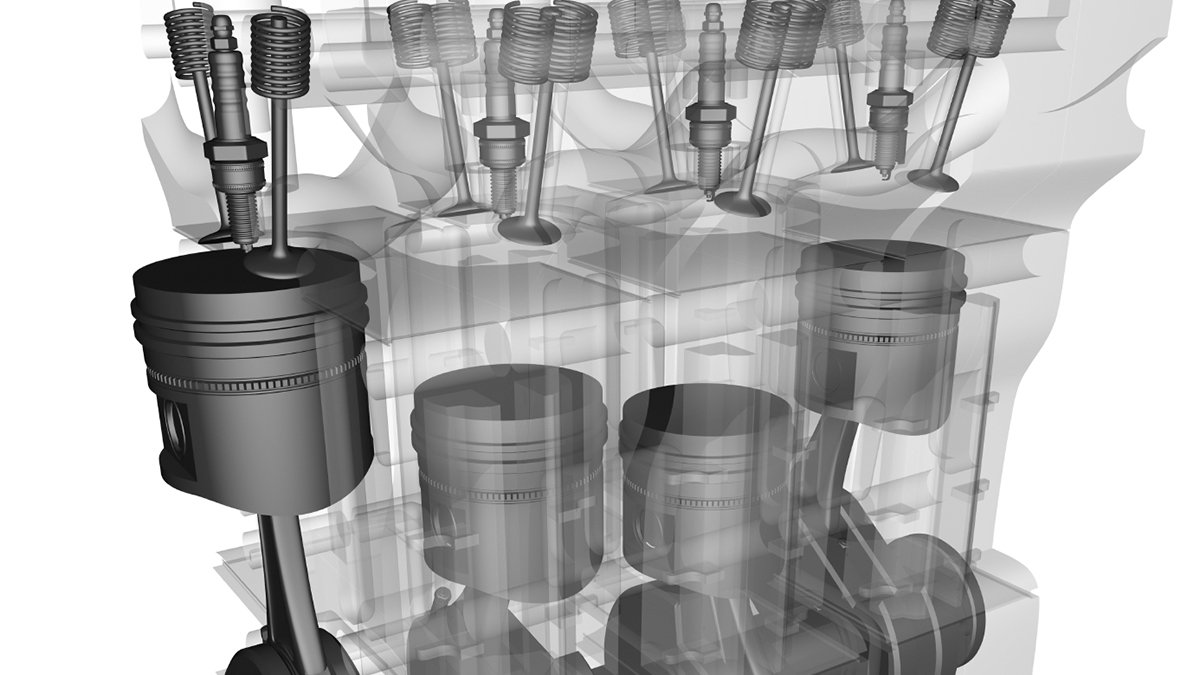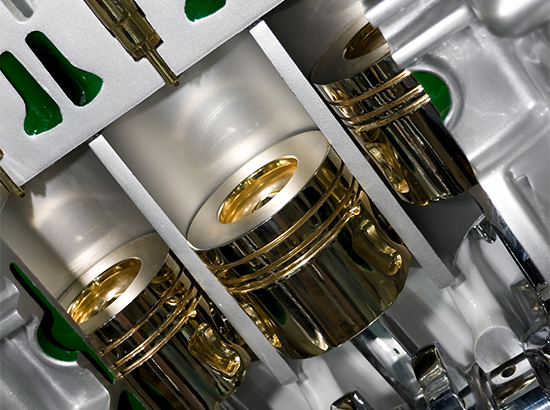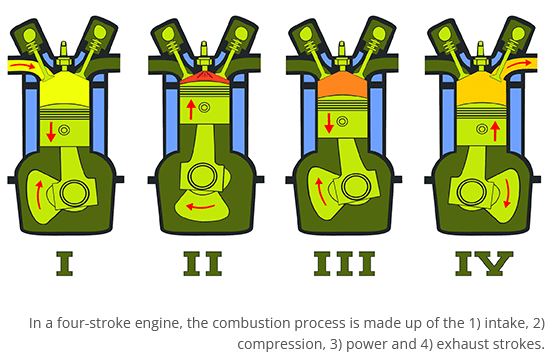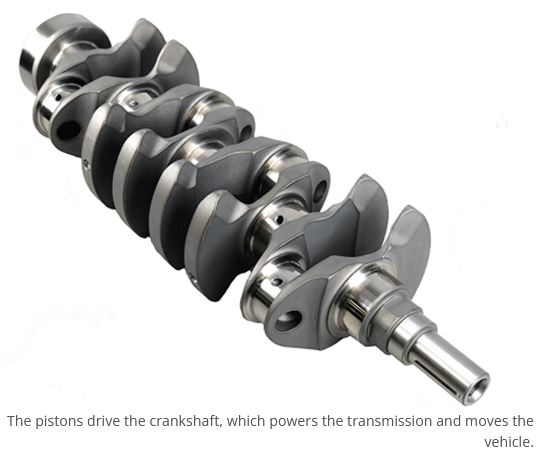How Does an Engine Work? Combustion & Components
An internal-combustion engine works by converting fuel and air into mechanical energy.
 by Brad Nelson|January 11, 2022
by Brad Nelson|January 11, 2022

The job of the engine is to transform fuel into energy. So, how does an engine work? Internal combustion engines create energy by burning a fuel-air mixture under pressure inside the cylinder, and it’s converted into movement by the engine’s pistons, connecting rods and crankshaft.
However, the design and function of components varies depending on the primary purpose of the vehicle, fuel type and other considerations. Let’s start with the basics of combustion and engine design.
Four Functions of Combustion
Four-stroke engines must perform four essential functions to operate properly and efficiently:
- Intake
- Compression
- Power
- exhaust
The intake function involves drawing a mixture of air and fuel into the combustion chamber. The compression function compresses the mixture. The power function involves igniting the mixture and harnessing the power of that reaction. The exhaust function expels the burned gases from the engine.
Piston and Piston Rings
The piston moves up and down, or reciprocates, inside the engine’s cylinder. In doing so, it helps complete the four functions of combustion, creating a vacuum that draws the fuel-air mixture into the combustion chamber (intake), compressing the mixture (compression), igniting it (power) and expelling the burned byproducts (exhaust).
The area above the piston is referred to as the cylinder or combustion chamber. Air and fuel are compressed and ignited in the cylinder. Piston rings below the piston crown form a seal against the cylinder wall to prevent fuel from leaking out of the combustion chamber and help prevent most of the combustion byproducts from leaking past the piston rings and contaminating the oil in the crankcase. The piston rings also help cool the piston by dispersing oil along the cylinder wall and transferring heat.

Connecting Rods and Wrist Pins
Connecting rods connect the piston to the crankshaft. A wrist pin is used to attach the piston to the connecting rod, allowing them to pivot as they reciprocate. Both the undercrown and wrist pin are exposed to extreme stress as they bear the force from the reciprocating pistons, most notably when the piston is driven down by the force of combustion.
How Does an Engine Work? Crankshaft
The crankshaft converts the pistons’ reciprocating action into rotary movement that is transferred to the transmission. In a typical consumer vehicle, the crankshaft is attached to the transmission via clutch (manual) or torque converter (automatic). In a lawnmower, the crankshaft is attached directly to the cutting blades.
Seals at the ends of the crankshaft prevent oil from leaking out of the engine. Seals in two-stroke engines have the added challenge of operating under the forces of positive and negative pressure created by the reciprocating piston. Four-stroke engine seals do not operate under such pressure.
Bearings
The engine’s main bearings support the crankshaft. Depending on the engine design, roller bearings or plain bearings may be used.
Roller bearings (anti-friction bearings) are used in two-stroke applications because a dedicated lubricant source is not available. Roller bearings contain moving elements and may also be referred to as roller-element bearings.
Plain bearings are fixed, non-moving bearings that provide support to the rotating crankshaft in four-stroke applications. They are designed to provide low-friction resistance and require a dedicated, pressurized lubrication source to provide an adequate fluid barrier between metal components.
Valvetrain and Valve Timing
The engine’s valvetrain is responsible for opening and closing the cylinder valves at the correct time during the combustion process. It consists of valves, valve-spring assemblies, camshaft(s), lifters, push rods and rocker arms.
The valves are used to either deliver the fuel-air mixture to the cylinder or allow exhaust gases to escape. Older vehicles used one valve for each function; however, newer vehicles use as many as two intake and two exhaust valves per cylinder.
The intake valve delivers the fuel-air mixture into the combustion chamber. The exhaust valve releases the exhaust gases from the cylinder.
Each valve has a valve seal that is responsible for keeping oil out of the combustion chamber. Valve seals that malfunction can cause oil to enter the cylinder and burn during combustion, causing your engine to burn oil.
Camshaft
The camshaft contains eccentrics and journals that control valve timing. Eccentrics are mechanical lobes that transfer reciprocating motion between mechanical components. Each eccentric controls one valve. For example, a four-cylinder engine that has two valves per cylinder will use a camshaft with eight eccentrics.
The shape of the eccentrics controls the finely tuned movement and timing of the valvetrain, including how far the valves lift, how long they stay lifted and when these movements occur relative to the position of the pistons.
The two main types of camshafts are flat-tappet and roller. The tappet, or lifter, on the flat-tappet camshaft is flat, and requires oil to separate its surface from the cam lobe. Flat-tappet camshafts produce high friction and high temperatures because the surfaces rapidly slide against each other. The oil film is the only barrier that prevents the lifter and the cam lobe from welding together.
Friction between the two components can eventually wear the flat-tappet cam down and affect valve operation. Engine power and efficiency will decline if the flat-tappet cams cannot lift the valves enough to adequately charge the chamber for ignition or release exhaust fumes.
The roller camshaft uses wheels, or rollers, to reduce tappet wear. The rolling element reduces virtually all friction between the tappet and cam lobe, helping extend camshaft life. Roller camshafts are generally preferred to flat-tappet camshafts because they significantly reduce wear and can enhance engine performance.
How Does an Engine Work? Engine Block Designs
Inline Engine
Inline engines arrange pistons in a single row. The inline engine block is a common layout found in various automotive and powersports applications, including snowmobiles, personal watercraft and motorcycles.
V-Style Engine
V-style engines have two rows of cylinders offset from each other so that they form a V shape. The v-style engine is a common automotive engine design. The large-bore motorcycle market also commonly uses this design.
Opposed Engine
Cylinders lie flat and are arranged perpendicular to either side of the crankshaft in opposed engines. Porsche* and Subaru* use the opposed engine block design in automotive applications, while Kohler* and Briggs & Stratton* are well-known for using opposed engines in lawnmower applications.
Rotary Engine
Known as the Wankel engine, rotary engines use a triangular rotor instead of pistons to produce power. Triangular rotors rotate inside a specialized chamber; one cycle consists of intake, compression, power and exhaust functions.
Because power comes from the revolving rotor instead of the reciprocating pistons, it operates smoothly with very little vibration. The rotary engine is found mainly in automobile applications, including the Mazda* RX7 and RX8.
As you can see, a lot goes into a properly working internal combustion engine. Hopefully, this helps answer the question: how does an engine work?



